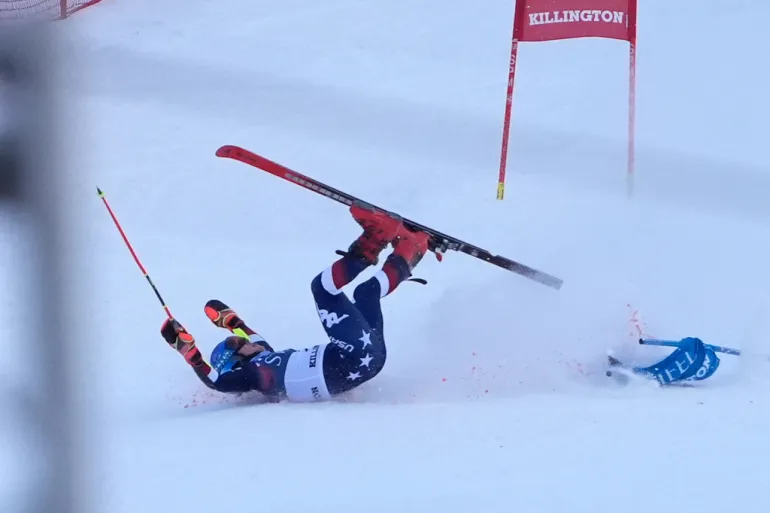
As the Olympic ski season kicks off just five months before the Milan Cortina 2026 Winter Games, athletes, coaches, and officials are clashing over the growing concerns surrounding unsafe ski training courses. The debate has intensified following a series of deadly accidents that have rocked the Alpine skiing world, prompting calls for urgent reform in how training facilities are prepared and regulated.
Mikaela Shiffrin Raises Alarm Over Dangerous Ski Training Conditions
Two-time Olympic champion Mikaela Shiffrin knows the risks all too well. After suffering a severe crash last year that left her with a punctured abdomen and damaged abdominal muscles, the American skiing superstar has become increasingly vocal about the need for improved safety standards during training.
“When I came back from injury, I was aware of the fencing on the side and a hole in the course and where the trees were,” Shiffrin said. “We often train in conditions where there are too many variables to control. You have to ask — is this unreasonably dangerous or just part of the risk we accept as athletes?”
Her comments echo a growing sense of unease among elite skiers who say training slopes often lack the same level of protection, medical support, and preparation as official race courses.
Fatal Crash Sparks Renewed Scrutiny Ahead of 2026 Olympics
The debate reignited in September when Italian World Cup skier Matteo Franzoso, 25, died after a training crash in La Parva, Chile. Franzoso reportedly broke through two layers of safety fencing and struck a wooden barrier placed outside the course, suffering fatal head injuries.
His death marked the third fatality among young Italian skiers in less than a year, and followed the death of a talented French skier earlier in April — both incidents occurring during training, not competition.
For many athletes, these tragedies have underscored the life-threatening risks of unregulated training environments.
“We’ve Become Blind to the Dangers,” Says Shiffrin
Shiffrin admitted that the mental toll of her accident lingered long after she returned to the slopes:
“If you think too much about the risk, you become paralysed. But ignoring it is worse. It’s not OK to just say, ‘risk is part of the sport.’ We have to acknowledge what’s life-threatening and take steps to prevent it.”
While skiing has always carried an element of danger, experts and athletes argue that much of the risk in training is avoidable — if only federations and organisers were willing to invest in proper safety infrastructure.
Training Courses Lack Race-Day Protections
Unlike official World Cup race venues, training courses are often underfunded and understaffed. They typically feature fewer safety nets, smaller maintenance teams, and limited medical personnel. In some cases, helicopters for emergency evacuation are not available at all.
Sofia Goggia, Italy’s 2018 Olympic downhill gold medallist, described ski racing as “an extreme sport” comparable to Formula 1 or MotoGP, where speeds can reach 90 km/h (56 mph).
“Race courses are safer because they’re heavily netted,” Goggia said. “But training slopes are a different story — there’s not the same organisation or investment.”
She added that the fatal Franzoso crash occurred while three national teams were using the same slope. “They must have seen the danger,” she said. “We can do more — but who will invest the millions it takes to make training as safe as racing?”
FIS and National Federations Under Pressure
In response to growing outrage, the International Ski and Snowboard Federation (FIS) has promised to take action. FIS President Johan Eliasch said the governing body is committed to “preventing as many horrible accidents as possible,” including reviewing training safety standards, rest scheduling, and on-site medical presence.
“We need to make sure that when skiers train for speed events, the safety standards match race-day levels,” Eliasch said.
However, coaches like Roland Assinger from Austria remain skeptical:
“A risk will always remain, but we try to minimise it. Copper Mountain in the U.S. is the safest training course in the world, with full netting. In South America, that level of safety just isn’t financially possible.”
The Cost of Safety: Who Should Pay?
Funding remains the core obstacle. Eliasch revealed that FIS has distributed nearly €100 million ($117 million) to member federations over the past four years, urging wealthier nations like Austria and Switzerland to invest more in safety.
“For smaller federations, this can be a challenge,” he said. “In those cases, FIS steps in to help.”
Christian Scherer, secretary general of Ski Austria, agreed that national coordination is essential. “Shipping extra netting overseas was a start,” he said, “but we need a unified global approach. Local resorts can’t shoulder this responsibility alone.”
A Call for Safer Skiing Before Milan Cortina 2026
As the Olympic countdown ticks closer, the skiing community faces mounting pressure to address safety shortcomings that have plagued training environments for years.
Athletes, federations, and event organisers all agree that change is necessary — but disagreement persists over who should fund and enforce those standards.
Until then, as Shiffrin put it, “the fine line between bravery and danger” continues to define one of the world’s most thrilling — and perilous — winter sports.


Leave a Reply